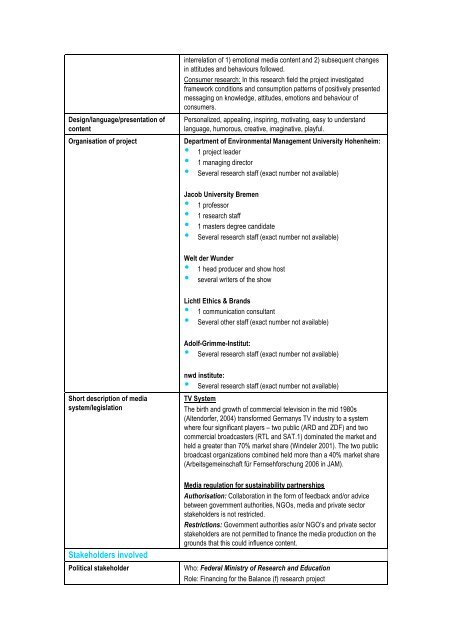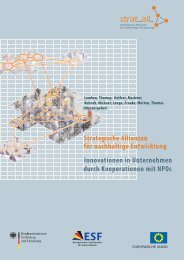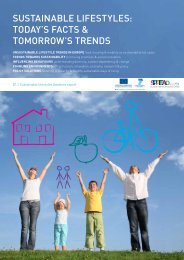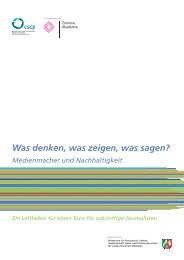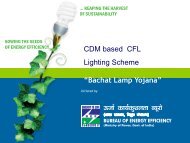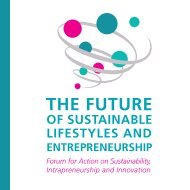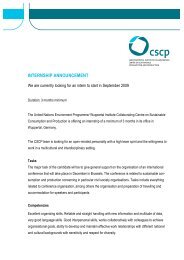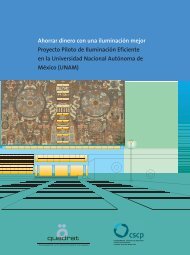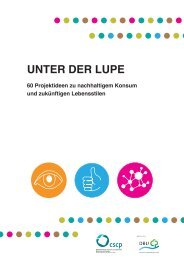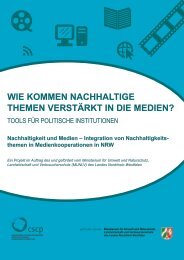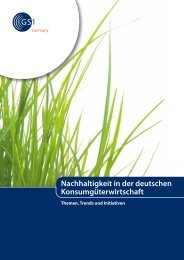integrating sustainability themes into media - Collaborating Centre ...
integrating sustainability themes into media - Collaborating Centre ...
integrating sustainability themes into media - Collaborating Centre ...
Create successful ePaper yourself
Turn your PDF publications into a flip-book with our unique Google optimized e-Paper software.
Design/language/presentation of<br />
content<br />
interrelation of 1) emotional <strong>media</strong> content and 2) subsequent changes<br />
in attitudes and behaviours followed.<br />
Consumer research: In this research field the project investigated<br />
framework conditions and consumption patterns of positively presented<br />
messaging on knowledge, attitudes, emotions and behaviour of<br />
consumers.<br />
Personalized, appealing, inspiring, motivating, easy to understand<br />
language, humorous, creative, imaginative, playful.<br />
Organisation of project Department of Environmental Management University Hohenheim:<br />
• 1 project leader<br />
• 1 managing director<br />
• Several research staff (exact number not available)<br />
Short description of <strong>media</strong><br />
system/legislation<br />
Stakeholders involved<br />
Jacob University Bremen<br />
• 1 professor<br />
• 1 research staff<br />
• 1 masters degree candidate<br />
• Several research staff (exact number not available)<br />
Welt der Wunder<br />
• 1 head producer and show host<br />
• several writers of the show<br />
Lichtl Ethics & Brands<br />
• 1 communication consultant<br />
• Several other staff (exact number not available)<br />
Adolf-Grimme-Institut:<br />
• Several research staff (exact number not available)<br />
nwd institute:<br />
• Several research staff (exact number not available)<br />
TV System<br />
The birth and growth of commercial television in the mid 1980s<br />
(Altendorfer, 2004) transformed Germanys TV industry to a system<br />
where four significant players – two public (ARD and ZDF) and two<br />
commercial broadcasters (RTL and SAT.1) dominated the market and<br />
held a greater than 70% market share (Windeler 2001). The two public<br />
broadcast organizations combined held more than a 40% market share<br />
(Arbeitsgemeinschaft für Fernsehforschung 2006 in JAM).<br />
Media regulation for <strong>sustainability</strong> partnerships<br />
Authorisation: Collaboration in the form of feedback and/or advice<br />
between government authorities, NGOs, <strong>media</strong> and private sector<br />
stakeholders is not restricted.<br />
Restrictions: Government authorities as/or NGO’s and private sector<br />
stakeholders are not permitted to finance the <strong>media</strong> production on the<br />
grounds that this could influence content.<br />
Political stakeholder Who: Federal Ministry of Research and Education<br />
Role: Financing for the Balance (f) research project


